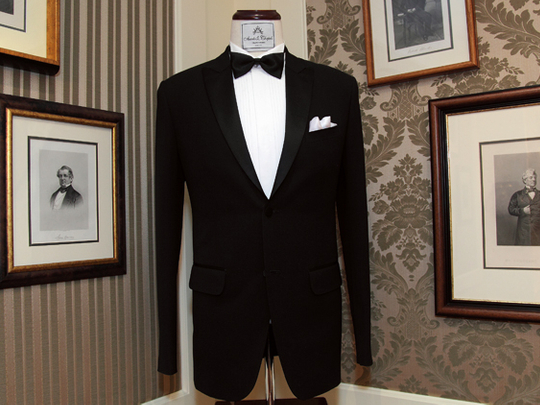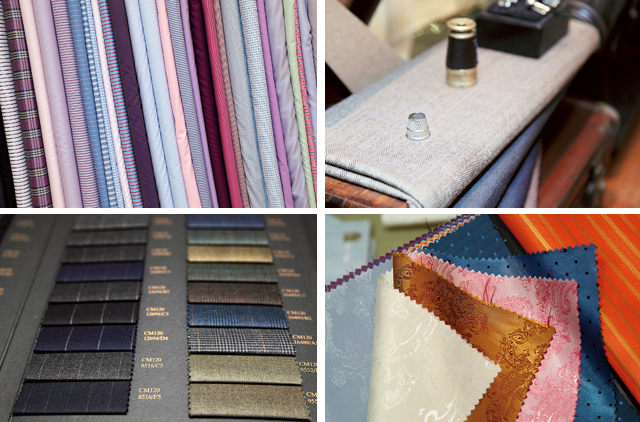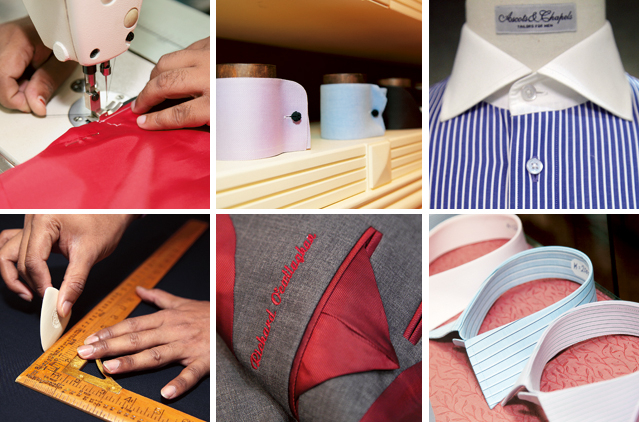
Tailoring is woven into the city's culture, as well as being one of the foundations of Dubai's booming retail sector.
With no shortage of talented tailors in town, getting a suit knocked up is an affordable way to customise your wardrobe and have complete control over the design, fit and material of your outfit.
By getting the most out of your tailor you can take a standard suit and introduce eye-catching personal touches that will take it to true bespoke standards.
Why bespoke?
Quality tailoring has always been the backbone of men's fashion. Since the emergence of men's fashion blogs and TV shows like Mad Men, appreciation for tailoring has been brought into the spotlight for style-conscious men with more emphasis on quality and design. However a trip to the tailor needn't be the same old cookie cutter experience for everyone. By getting the most out of your tailor you can take a regular suit design and add those vital finishing touches to bring it up to true bespoke standards.
The right man for the job
Finding the right tailor, as with establishing any working relationship, is a case of finding someone who reflects your vision. Here, it's about a tailor who will take your vision and make it a reality.
A good tailor will listen to and understand your needs without issue but at the same time offer their experience and make suggestions to work with your body's idiosyncrasies.
In Dubai, you generally get what you pay for but by working closely with your tailor you should be able to get a suit that matches the one you had in mind. Don't be afraid to draw diagrams and write notes telling them exactly what you want. Stories abound of men visiting the less expensive tailors and ending up with a suit devoid of specific requested features, like surgical cuffs, or no belt loops.
Try to eliminate these misunderstandings by insisting on at least two trial fittings - even if you are getting them to copy an existing suit that fits you perfectly.
Each tailor you interview may have its own "house style", be that contemporary, Italian or British. Ascots & Chapels is a classic example of British tailoring in town. Generally, the British suit has a more slender formal look with structured shoulders and a cinched waist. Over the decades the classic British look has evolved through time. From the dandy Oscar Wilde through to Sixties Mods and even today's politicians, classic British tailoring has been the backbone of sartorial style for modern men. This style can be worn casually at functions or comfortably around the office. By using only selected cloths, Ascots & Chapels is the perfect place for those looking for a sharp, contemporary, comfortable finish with the quality and service you would expect from a bespoke tailor.
First things first
Identify when you're likely to wear the suit you're investing in. By identifying its purpose you can then select the fabrics, styles and colours to match. It could be a suit for formal evening wear, something for the office, or a versatile blazer or jacket.
Think about the details; perhaps you're after an extra blazer pocket for your smartphone, or maybe a trouser finish or fabric that helps to add a few inches to your body length.
Cloth that makes the grade
Tailors will often only work with in-house approved cloths. However, most tailors in town will be more than willing to work with fabrics purchased elsewhere. Blessed with its geography, Dubai is a draw for fabric traders from all over the world and in particular the sub-continent.
The city's world-renowned textile souk and neighbouring Bur Dubai are prime starting points for opening up to a wealth of fabric choices and affordable tailoring. If you find the hustle and bustle of the souk a little overwhelming, Deepak's House Of Textiles in Satwa offers a vast selection of fabrics with just about every pattern imaginable all under one roof.
When selecting cloth, refer back to the suit's original purpose. Go with the feel of the cloth and what works best for your vision and budget. Listen to your wallet but remember that purer wools do make for a higher quality garment. The wool ‘Super' grading system is used to grade the quality. The higher the number, the more yarn is packed in per square inch ranging from the cheaper ‘Super 80' to the ‘250' that even James Bond would struggle to afford.
Go for the heaviest cloth your body can handle as heavier cloths last longer, require less pressing and hang better for a more shapely fit.
Lightweight linen suits work well in the testing Dubai climate but are a nightmare to maintain. Unless you want to take an iron to the office every day, stay clear. Linen creases and picks up stains easily.
Tweed and flannel are currently experiencing a renaissance. Tweed is a rough, woven cloth initially favoured by Edwardian game shooters and academics in the mid 1960s. Tweed isn't a typical choice for hotter climates or a slim look but it can add an air of Balmoral sophistication if you're looking for a unique blazer. Flannel is a softer fabric, also perfect for cooler climes and traditionally made from wool.
Synthetic materials like Polyester or Teflon, though cheaper, do sacrifice quality. They don't breathe like natural materials and can appear coarse and shiny. However, there are acceptable synthetic/wool blends out there. For the price sensitive, Lobo's of Bur Dubai offers a selection of affordable wool blends and synthetics as well as pure wools imported from all over the globe.
Shades and shapes to suit
Colour and pattern will be determined not only by your tastes but by the suit's function and your shape. Solid blacks and dark blues are ideal for bulkier men who want a slim but functional look. Bigger chaps should try to stay clear of larger patterns and instead opt for a vertical pinstripe on a soft grey colour to elongate the body.
Shorter men are free to work with all colours but it's best to stay clear of larger patterns. Pinstripes draw the eye upwards and give the illusion of being taller whilst tightening the shape.
If you're blessed with height and a little less bulk, try lighter colours to work with your body's natural lean shape. Solid light colours and patterns will look fuller on you and complement your body's size.
Make that a double?
The look of the top half of your suit will depend on whether it is single or double breasted. Double breasted jackets are typically longer in length so favour the taller man looking for a more conservative, elegant look. Single breasted will give you more versatility when piecing together your overall look.
Whether you go for single or double breasted, the width of lapel will depend on your shirt and tie sizes. Most modern trim suits will favour a thinner lapel to match with a skinny tie, whereas thicker lapels will work with a broader tie and collar.
The most common types of lapel are Notch (also known as Step), Peaked and Shawl. Notch is your classic lapel sewn at an angle from the collar; perfect for a diverse single breasted jacket.
Peaked lapels are more formal, typically seen on dinner jackets and double breasted suits. Peaked lapels are in vogue right now as more men look go for a dandy Sixties look.
Shawl lapels are a continuous curve from the collar and look great on casual lounge jacket.
Giving vent
You need to look good in your jacket but you also need to be able to move - and look good on the move. This is where the vents come in. A single vent works with a versatile single breast or a blazer. Double vents are best for a double breasted look or even on single breasted for those wanting more movement when getting in and out of the office chair or car. Ventless jackets are more common in formal dinner looks or lounge blazers.
A silver lining?
The inside of your jacket is every bit as important as the outside. With the jacket lining you have free rein to be as vivid or lavish as you wish. Having your own signature or name inscribed on the inside is the definitive final touch to any bespoke suit.
Working it
Few men are aware that working sleeve buttons are an option. Working buttons, known as "surgeon's cuff" are a great little finishing touch to your jacket and will take your tailoring to another level. Work out how long your sleeves should be based on how much of your shirt cuff will be exposed.
Pocket watch
Flap pockets are the most common choice. The pocket is stitched inside the jacket but with an external flap matching the cloth of the jacket. Adding an extra small pocket above the right side pocket will add extra purchase to any double breasted suit.
Jetted pockets, though similar to flap, are found on formal dinner jackets but instead of a flap there is a thin slit with a small line of fabric. Patch pockets, where the pocket is stitched on the outside, are commonly seen on sports coats or less formal jackets. Pockets are an excellent way of synchronising your look with the jacket's everyday use.
Outside pocket sizes can be adjusted in depth and length depending on where and how you use them. On the inside, pockets can be stitched to accommodate your phone, pen or business cards.
The perfect trio
If you're looking to put together a three piece, waistcoats are like an extension of the jacket. Much like the lining of the jacket, you have a free rein however it's best to keep it simple and work with matching colours. Contemporary waistcoats are flat at the front without lapels, however adding lapels is a great way to take your three-piece suit to Mayfair standards.
The bottom half
Trousers traditionally come with one, two, or no pleats (known as ‘flat front'). Depending on your height and width, pleats can add length and shape to your legs. Pleats are a good look for taller and more average sized men, while bulkier chaps are best off with a ‘flat front' leg.
Cuffs at the bottom of trousers help the cloth to drape better on the leg, therefore should only be worn by taller men. If going for the more formal double breasted look, both pleats and cuffs should be worn. Bigger and shorter men should stick to a straight, cuff-less leg.
Waistbands need not have the usual belt loops. Side buckles eliminate the need for a belt and give you an extra inch for adjustment or if you prefer braces, suspender buttons can be stitched to the inside of a regular waistband.
It's even possible to request a pocket within your trouser pocket to house your Metro card, pen or smartphone.
Bespoke in Dubai
Ascots & Chapels
Dubai Marina Mall, Souk Al Bahar, Old Town and DIFC. Call 04 325 2216
Classic British bespoke tailoring with an eye on contemporary styles.
Price: Dh2,500 (average price for a suit)
Deepak's House Of Textiles
Opp. Emcas Station, Satwa. Call 04 344 3536
A textile emporium in Satwa with fabrics from all over the world.
Savile Row
Jumeirah Beach Residence, Dubai. Call 04 4233813
Tailoring which seeks to replicate the high quality produced on the street of its English namesake.
Price: Dh2000
Kachins on 44 Street
Khalid Bin Waleed Road. 04 355 7044
Long established tailors in the heart of Bur Dubai.
Price: From Dh1,800
Leonard Logsdail
Warehouse 17b, Street 6, Al Quoz. Call 050 600 3224
Independent British tailor in Dubai.
Price: Dh17,500
Lobo
Cosmos Lane, Bur Dubai. Call 04 352 3760
One of the oldest tailors in town. Friendly staff and ideal for those in need of quick service.
Price: Dh1,200
Royal Fashion
Pyramid Building, near Burjuman Centre, Bur Dubai. Call 04 396 8282
Royal Fashion Men's Tailoring has several branches across Dubai
Price: Dh1,500















